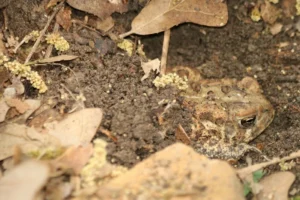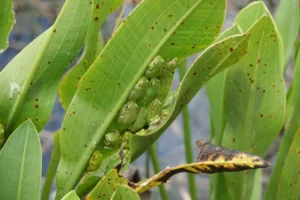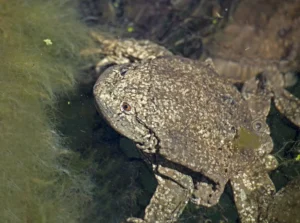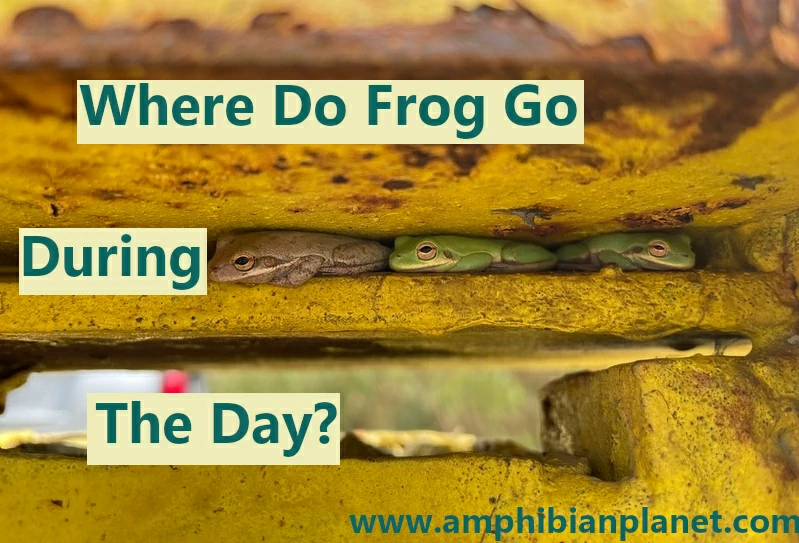The majority of frog species are primarily either nocturnal or crepuscular and are most active in the dark and twilight hours. When inactive, they retreat to cool, sheltered locations where they can conserve energy, and avoid predators such as hawks that are active during the daytime.
During the day, terrestrial frogs seek cover under rocks, in leaf litter, or even in underground burrows. Arboreal frogs seek cover in tree hollows, bromeliads, the cavities of large flowers, and the leaf sheaths of large leaves. Aquatic frogs seek cover between submerged rocks, in the roots of aquatic plants, and in other sheltered aquatic locations.
Where frogs go during the day is mainly dependent on the type of habitat they are adapted to.
Terrestrial Frogs Seek Cover In Sheltered Locations During The Day
Terrestrial frogs are highly adapted for life on land. When they are inactive during the day, they retreat to cool areas on the ground that are sheltered from direct sunlight and also offer some form of protection against predators.
During the day terrestrial frogs will seek cover:
- In damp leaf litter, compost heaps
- Inside hollow logs, cracks in logs
- In thick, shady vegetation
- At the edge of ponds
- In caves, rock crevices, and cracks in the foundations of old buildings
- Under rocks, logs, piles of rubble, paving slabs, and other objects
If you ever go around turning over large rocks, or logs during the day, particularly during the wet season, there’s a chance you could find frogs or toads hiding underneath.
Many terrestrial frogs will also retreat to underground burrows. Since most frogs cannot dig their own burrows, they look for natural holes or abandoned small mammal burrows.
Some burrowing frog and toad species may also dig their own burrows.

Toads are known to dig deep down into loose soil. Many toads have special, hardened knobs on their hind feet that help them dig into the soil. They use their back legs to ‘knead’ their bodies into the soil, burying themselves completely.
How deep they dig can vary from time to time. Some toads can burrow anywhere from 6 inches to over 3 feet deep.
Arboreal Frogs Seek Cover In Trees And Other Vegetation During The Day
Arboreal frogs spend most of their time in and around trees, and their bodies are highly adapted to this lifestyle.
Many tree frogs have small light bodies that allow them to sit on leaves and cling to weak branches without falling. They also have long toes that allow them to wrap around small branches.
Their toes have large, round toe pads that help them cling to branches. These toe pads work like suction cups to help the frog cling to wet leaves and other smooth surfaces. These “sticky toes” mean tree frogs can even cling to glass!
During the day, arboreal frogs will seek cover:
- On leaves
- In thick vegetation
- In tree hollows
- In bromeliads
- In the cavities of large flowers
- In the leaf sheaths of large leaves (such as banana leaves), and other cool, hidden locations in the canopy

Some frogs are semi-aboreal and spend part of their time in short shrubs and other vegetation, and at the base of trees, or even on the forest floor.
During the day, these frogs can be found hiding in the surface roots of trees, in thick shrubs, grass, and other short vegetation, and even in damp leaf litter on the forest floor.
Aquatic Frogs Seek Cover Underwater During The Day
Aquatic frogs spend most of their time submerged in water and have several adaptations for this lifestyle. Some aquatic frogs have bodies that are flatter than those of other frogs, giving them a larger skin surface area to absorb oxygen from the water (cutaneous respiration).
Some aquatic frogs have other unique adaptations for their aquatic lifestyle. For example, the Titicaca water frog (Telmatobius culeus) has a wrinkled, excessive amount of skin that makes it look rather as if it were wearing an oversized wet suit.

But this skin performs a very important function– it provides a bigger surface area to use for cutaneous respiration.
For this reason, Titicaca water frogs have greatly reduced lungs – less than one-third the size that would be expected of other frog species of the same body size.
Because of their large skin surface area, these frogs mainly breathe through their skin, and only occasionally use their lungs. In fact, they can stay submerged for several days, breathing only through their skin, without using their lungs.
Some mostly aquatic frogs such as the tailed frogs the genus Ascaphus, are adapted to living in cold, fast-moving streams, and have distinctive anatomical features for this lifestyle.
During the day, aquatic frogs will seek cover:
- In areas sheltered by aquatic vegetation
- Among the roots of aquatic plants
- Under submerged rocks, logs, and in any type of underwater shelter
Some aquatic frogs occasionally leave the water and seek cover under large rocks, or logs close to the water body.
Tailed frogs have also been found in crevices in spray-drenched cliff walls near waterfalls.
Common Questions About Where Frogs Go
Do frogs come out during the day? The majority of frog species are primarily either nocturnal or crepuscular and generally do not come out during the day. During the day, frogs seek cover in shady, cool locations that are sheltered from direct sunlight and also offer some form of protection against predators. However, frogs may come out during the day, in wet, cool weather after it rains.
Do frogs make noise during the day? Frogs occasionally make croaking noises during the day, especially after it rains, or during wet weather. However, they are generally louder at night, as croaking during the day may attract the attention of predators such as hawks.
Where do frogs go during the day? During the day, frogs seek cover in shady, cool locations that are sheltered from direct sunlight and also offer some form of protection against predators. This could be under large rocks and logs, in leaf litter, in thick vegetation, or under submerged substrates, depending on the species
Conclusion
Most frog species are primarily nocturnal or crepuscular and are most active in the dark and twilight hours.
The darkness of the night means frogs are less vulnerable to predators such as hawks that are more active during the day.
Frogs also blend into their environments easier to hide and avoid active predators in the cover that the darkness provides.
During the day, frogs will retreat to cool, hidden locations, where they can rest, and also avoid being seen by predators.
The place where a particular frog will go during the day is mainly dependent on its species.
Featured image credit: carly_c (CC BY-NC 4.0)


